NGC Ancients: The Coinage of Ancient Carthage, Part 4
Posted on 9/14/2021
In the previous column we focused on Carthaginian coins from the city’s colonies in Spain. In this final installment we’ll cover the remaining coinage of the empire of ancient Carthage, from the Second Punic War (218-201 B.C.) until the sacking of the city in 146 B.C.
The Second Punic War sprung from Carthaginian discontent about the treaty terms and reparations due to Rome from the First Punic War (264-241 B.C.). This allowed for warlike leaders in Carthage to take command, the most famous being Hannibal.
The conflict was sparked in 219 B.C. when Hannibal conquered the pro-Roman city of Saguntum in Spain, causing the Romans to declare war. Hannibal surprised the Romans when he led his armies on a daring march to the Alps, crossing them in the peak of the winter of 218 B.C. and descending into the heart of Northern Italy. He went on to defeat army after army and was almost unbeatable during the next few years he was in Italy.
The Carthaginian coins of the Second Punic War were struck in many locations, which led to many different designs being used. We’ll review a few of the coins minted at Carthage itself and then look at coins minted in other locations by the Carthaginians or their allies.
 |
The quarter-shekel above, from c.216-211 B.C., was struck by the Carthaginians at a military mint in Southern Italy. The detailed portrait of Tanit is of a pleasing style.
 |
This 30 mm bronze is from the early stage of the Second Punic War. It has a well-struck Tanit and a horse standing in front of a palm tree. Compared to similar earlier bronzes, this representation of Tanit is more detailed and life-like.
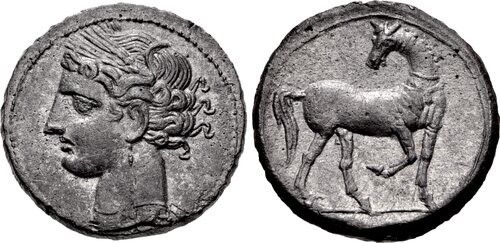 |
The tridrachm above, from c.203-201 B.C., was made of billion or debased silver. The lower metal quality presumably highlights the difficulties Carthage faced as the war drew to a close.
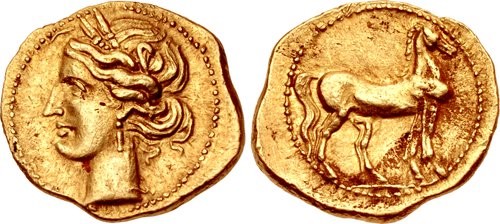 |
This 1/5th stater, made during the same period as the previous coin, also reflects the economic pressure mounting on Carthage. The engraving seems almost rushed, and the planchet and strike quality are not good, especially when compared to earlier Carthaginian gold and electrum coins.
While fighting in Italy, Hannibal tried to find new allies to bolster his army and supplies. Some of the cities in Southern Italy allied themselves with Carthage and threw off their allegiance to Rome. Some of these cities began to mint coins, which often would mimic those already being made in the city, or which had been made in the past.
 |
While most of the war took place on Italian soil, there were other theaters of action, including the island of Sicily. The half shekel above was minted c.213-211 B.C. at Acragas, a main city on the southern shore of the island. The obverse has a male head of uncertain identity, and the reverse has a leaping horse.
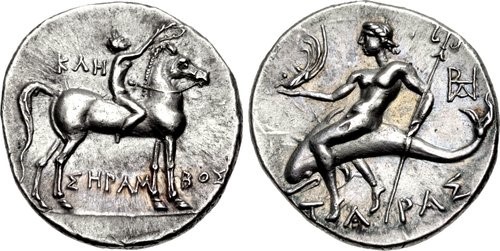 |
The city of Taras was an important port city in Southern Italy. Initially it was not allied with Hannibal, but after several efforts he finally took control of the city late in 213 or early in 212 B.C. Despite this success in taking the city, Hannibal never gained control of the port due to a group loyal to Rome holding a citadel which commanded the port.
The silver half shekel shown above, issued by Hannibal at Taras from c.212-209 B.C., mimics the traditional coin types of the city with a rider crowning a horse and a boy riding a dolphin. The dolphin rider is perhaps Taras or Phalanthus, both central figures in the city’s foundation mythology.
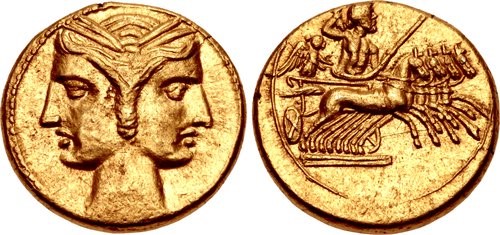 |
The electrum 3/8ths shekel above is one of the more intriguing coins of the Second Punic War. It was struck c.216-211 B.C., but scholars have differing views on its mint. Some believe it was from the city of Capua in Bruttium — one of Hannibal’s early strongholds — while others think it was made in Carthage and sent to Italy to help Hannibal.
The coin has a beautiful design, pairing janiform female heads with an energetic scene of Nike piloting a fast quadriga, with passenger Zeus, as if charging into battle. The design is remarkably similar to a contemporary Roman silver coin, a quadrigatus, and there is no reason to doubt that the Carthaginian supporters copied the Roman design because it would be familiar and more readily accepted in the local area.
In the spring of 204 B.C. the Romans dispatched an army led by the renowned general Scipio ‘Africanus’ to invade Africa in an attempt to end the war. After a few local armies were defeated, the Carthaginian government recalled Hannibal from Italy to defend his homeland. He evacuated in 203 B.C. and sailed for North Africa.
Hannibal engaged Scipio with his veteran army but was soundly defeated in 202 B.C. at the Battle of Zama. Carthage was forced to sue for peace and to accept another treaty from the Romans in which she had to give up all of her overseas territories, pay a large reparation and promise not to wage war outside of Africa.
The Carthaginians were humbled once again by their defeat and the humiliating treaty they signed resulted in an uneasy peace for the next 50 years between the two empires.
 |
The Third Punic War (149-146 B.C.) was waged entirely in Africa and saw the destruction of the city of Carthage and her empire. The war began when Carthage raised an army to defend itself from their Numidian neighbor. Rome saw this army as a threat and reacted by sending its own army to Africa.
Issued prior to the Third Punic War, in the period c.160-149 B.C., the gold 4/5ths shekel shown above features Tanit and a muscular horse standing proudly.
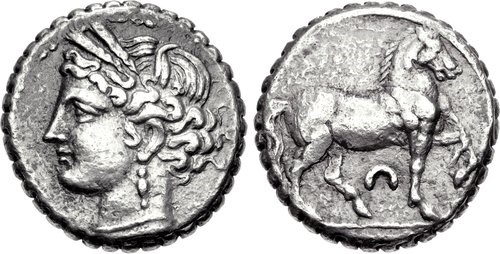 |
The billon dishekel above, from c. 149-146 B.C., has a similar design as the coin minted during the earlier era of peace. Some Carthaginian coins of this era — including this and the following piece — have serrated edges. The reason for this is not known.
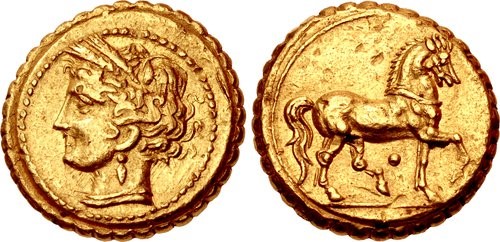 |
The gold shekel above is from the same period. It’s interesting to recognize that the Carthaginians could mint a coin of such size and purity at a time when financial resources no doubt were stretched.
The war ended after a siege of three years. The city of Carthage fell in a furor of killing and burning. Around 50,000 Carthaginians were left alive to be sold into slavery and the city was broken apart and cursed by the Romans. The once-great empire ceased to exist and would never rise again.
Much of the city's culture and history faded over time, but the coinage of Carthage would survive, and while the designs can be repetitive, it allows us to see the evolving prosperity of a country over the course of its long existence.
All photos courtesy of Classical Numismatic Group.
Interested in reading more articles on Ancient coins? Click here.
Stay Informed
Want news like this delivered to your inbox once a month? Subscribe to the free NGC eNewsletter today!
